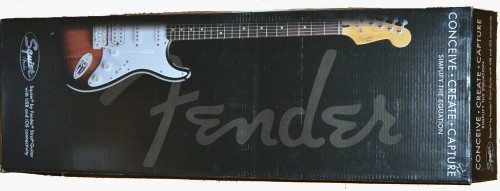 Computers and software have transformed the recording industry for even amateur musicians. No longer do you have to rent expensive time in recording studios to make professional-sounding recordings. A quick Google search will find multiple stories about entire albums being recorded on an iPad or an iPhone. If you intend to use only virtual instruments, all you need is GarageBand and an iPad or Mac, but it isn’t quite so simple if you want to record real instruments. To connect a real guitar, you need some sort of interface equipment, and my husband Butch and I have reviewed two of these interfaces, the Behringer Guitar Link UCG102 USB interface and the Positive Grid JamUp Plug, in the past year. (See related posts at the bottom of this post for links to those reviews.) Both of those devices worked extremely well, but you still had to keep up with a separate device.
Computers and software have transformed the recording industry for even amateur musicians. No longer do you have to rent expensive time in recording studios to make professional-sounding recordings. A quick Google search will find multiple stories about entire albums being recorded on an iPad or an iPhone. If you intend to use only virtual instruments, all you need is GarageBand and an iPad or Mac, but it isn’t quite so simple if you want to record real instruments. To connect a real guitar, you need some sort of interface equipment, and my husband Butch and I have reviewed two of these interfaces, the Behringer Guitar Link UCG102 USB interface and the Positive Grid JamUp Plug, in the past year. (See related posts at the bottom of this post for links to those reviews.) Both of those devices worked extremely well, but you still had to keep up with a separate device.
Fender recently introduced a USB guitar that eliminates the need for a separate interface. Their Squier by Fender Strat Guitar with USB and iOS Connectivity requires nothing more than a miniUSB-to-USB cable to connect to your Mac or PC or a miniUSB-to-30-pin-connector cable to hook up to your iPad, iPhone or iPod touch. (You’ll need a Lightning adapter if you want to use this guitar with the latest generation iOS devices.) I purchased one of these guitars for Butch for Christmas, and I thought he should try it out to be sure it was okay before I wrapped it up and stuck it under the tree. Because it meant he got to play with it a bit longer, he agreed to record a couple of GarageBand samples for us, too. Let’s see what he thinks about this inexpensive USB guitar.
All images can be clicked for a larger view.
Right now, the Squier USB guitar is available only from Apple. Perhaps some of the Apple stores in larger cities have them on site, but the Greensboro store didn’t have one for Butch to look at. He actually was a bit hesitant to order one sight unseen, because he was afraid he wouldn’t like how it played or sounded, especially considering how cheap it was. He said he liked the guitars he already had, and he liked the Behringer interface, and he just didn’t see the need for this guitar. I’m persistent, though, and he finally agreed to stop my harping about it after he read some favorable reviews of the guitar. I placed my order and waited only a couple of days for the guitar to be delivered to my home.
Squier guitars are Fender’s “entry level” instruments. This particular instrument has a solid-body construction in the Fender Stratocaster shape. It’s available only in the color you see in this review, which I’d guess is the Tobacco Sunburst, based on the color charts at Fender. It’s available only as a right-handed guitar – sorry, lefties.
There aren’t any tech specifications about the guitar at the Fender site or at Apple. The manual is a single, small sheet of paper with no information other than the names of the parts of the guitar. I really don’t remember where I saw this, because I read quite a bit of information before I decided I wanted to get one for Butch, but I remember seeing that the body is made of basswood and the neck is maple with a rosewood fretboard. I can’t find any official confirmation of materials. The packing box only says the guitar was made in Indonesia.
In the Box

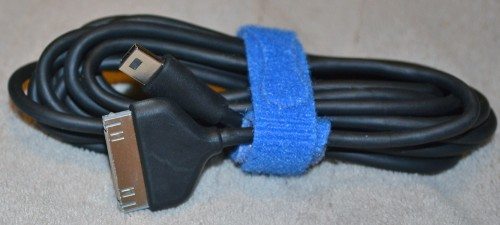
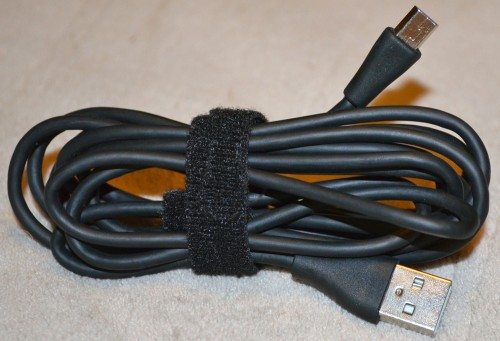
- Squier by Fender USB Stratocaster guitar
- Tremolo bar
- USB Mini-B – USB Type A cable
- USB Mini-B – 30-pin iOS cable
- User manual (Basic setup guide)
Each cable is 6.5 feet long. (The cables are shown with Op/Tech Strapeez cable wraps that I added.) Although they look like standard cables, they “offer bi-directional audio streaming.” This means the signals travel from the guitar to the recording computer/tablet, where they are processed and then returned to the headphone jack in the guitar so you can monitor what you are recording. Butch said the only way he could hear what he was recording on the iPad was through the headphone jack. (Plugging in the cable to the 30-pin connector on the iPad apparently disables the headphone jack on the iPad itself.) He could monitor his recording through the computer’s speakers or his headphones when using GarageBand on the Mac mini.
The Squier USB guitar didn’t come with a case or even a gig bag. I bought a Fender bag as part of the gift, which cost about $50. Butch says Fender’s choice not to include a bag was the right choice; the cost of the missing bag was better spent on the guitar construction anyway.
The Guitar
I was a bit disappointed that the guitar was only available in this two-tone color. I’d never seen a Sunburst up close, but I always thought the Sunburst guitars I’d seen in pictures looked dark and drab. I was pleasantly surprised when I opened up the box and saw the guitar. The lighter, inner color is a bright, glowing amber/honey color that shows the wood grain, and the dark outer color is opaque black or very dark brown. The white pick guard looks nice with these colors and brightens up the overall look.
The finish looks smooth as silk, without bubbles or flaws that I could see. It feels smooth as silk, too. I didn’t weigh or measure the guitar, but it seems to be a standard size and weight. Butch agrees with that assessment. Adding the USB circuitry didn’t add any appreciable weight to the guitar.
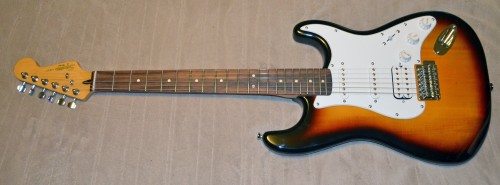 The above picture is twice the size, when clicked on for the enlargement, that I normally use with my reviews so you can get a better look. The hardware is shiny and looks like chrome. The headstock does look like maple, and the fretboard is rosewood with pearlescent, round Fender-style inlays.
The above picture is twice the size, when clicked on for the enlargement, that I normally use with my reviews so you can get a better look. The hardware is shiny and looks like chrome. The headstock does look like maple, and the fretboard is rosewood with pearlescent, round Fender-style inlays.
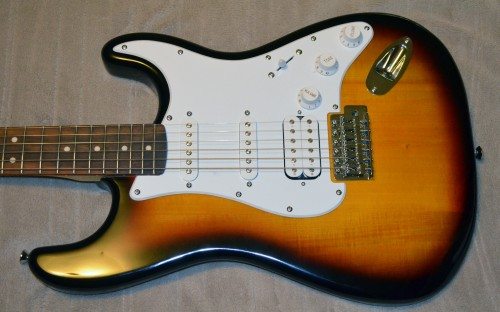 You’ll notice there’s a standard analog output jack on the front, so you can plug this guitar up to your standard pedals and amps, too. It has three knobs: the top one is master volume, middle is tone, and the bottom knob is the volume for the headphone jack (as you view them while playing). The pickup selector is a five-position rocker switch. There are three pickups; the neck and middle pickups are single coils, and the bridge pickup is a double coil. I couldn’t find anything that specified exactly what type of pickups were used.
You’ll notice there’s a standard analog output jack on the front, so you can plug this guitar up to your standard pedals and amps, too. It has three knobs: the top one is master volume, middle is tone, and the bottom knob is the volume for the headphone jack (as you view them while playing). The pickup selector is a five-position rocker switch. There are three pickups; the neck and middle pickups are single coils, and the bridge pickup is a double coil. I couldn’t find anything that specified exactly what type of pickups were used.
The guitar came pre-strung, but it did need to be tuned before playing.
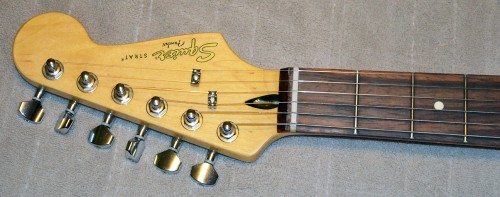 The headstock shows the Squier by Fender logo.
The headstock shows the Squier by Fender logo.
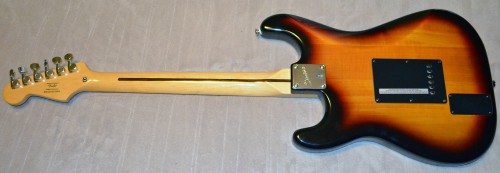 Here’s the back. The black streak up the neck is an inlayed strip of dark wood.
Here’s the back. The black streak up the neck is an inlayed strip of dark wood.
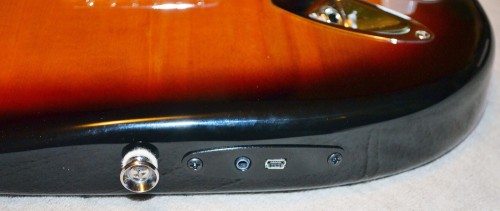 The miniUSB port and the headphone jack are on the bottom, near the strap connector. Putting them here minimizes the impact they have on the look of the guitar, but it’s not a good location for them. You can’t set the guitar down on its end when the cables are plugged in without using a guitar stand, or you risk damaging the cable or the connector itself.
The miniUSB port and the headphone jack are on the bottom, near the strap connector. Putting them here minimizes the impact they have on the look of the guitar, but it’s not a good location for them. You can’t set the guitar down on its end when the cables are plugged in without using a guitar stand, or you risk damaging the cable or the connector itself.
Playability and Sound
I’ll try to convey everything that Butch told me as well as I can.
He says the action on the strings is very low and very consistent, so it’s very easy to play. Despite the very low action, there was no fret buzz anywhere on the fretboard. Once the guitar was tuned, it held the tuning very well, despite a lot of string bending. Butch says the USB Squier plays really well, especially considering the price. He says it actually plays really well for a guitar of any price.
The sound from all five pickup selections was good – deep and rich. All positions give very different sounds, but all are rich and clean sounding. The neck-position pickup gives a traditional “thick, fat Strat sound”. Butch says the bridge pickup position is “hot and twangy”, probably because it’s a double coil.
Recording with GarageBand
We have GarageBand on our Mac mini, and Butch also has it on his 3rd generation iPad. Although the Squier USB guitar is compatible with Windows PCs, we didn’t have one to test the guitar with.
Butch started with the Mac mini. He simply plugged the cable into the guitar and computer and was ready to start recording. He recorded a track for us. In this song, he recorded one track with the USB guitar. It’s the very bright, very clean lead melody. All other instruments are virtual instruments in GarageBand.
MBP GB
He had an initial problem with recording on the iPad. He rebooted the iPad itself hoping to clear up the problem, but he said he still couldn’t monitor the recording. It finally occurred to him that the headphone jack on the iPad was disabled by the miniUSB-to-30-pin-connector cable. Once he plugged the headphones into the headphone jack on the guitar, everything was fine. The iPad song is shorter, but he recorded three tracks with the USB guitar for this song. The first track uses a very clean sound while playing chord arpeggios; the second is a high-gain, distorted sound for power chords; and the third track is a clean signal with delay and reverb for the lead melody. GarageBand virtual instruments provided the drum and bass tracks.
Butch said there was absolutely no latency using the Squier USB guitar with GarageBand on either the Mac mini or the iPad. He said he couldn’t quite quantify it, but he felt everything sounded “better” while recording on the iPad. He doesn’t know quite what the differences were that made him feel this, but we may have discovered the problem while photographing everything for this review. The miniUSB end of the cable used for the Mac recording was a little bent – sitting crooked in the rubber jacket where the plug attaches to the cable. We don’t know if the cable came that way, or if he forgot and set the guitar down on its end while the USB cable was plugged in and damaged the cable. We don’t actually know if the cable had anything to do with the perceived differences in recording on the Mac and on the iPad. In any event, Butch is in the process of contacting Fender customer support to see if he can get a replacement miniUSB-to-USB cable. Wouldn’t it be nice to learn that the “bi-directional” cable is just a standard USB cable that he can pickup locally if he damages one in the future?
In Conclusion
Butch is very happy with the Squier by Fender Strat Guitar with USB and iOS Connectivity. He says it plays and sounds like a much more expensive guitar. Recording is effortless on either the Mac or the iPad, and he doesn’t have to bother with a separate interface or special software required by some of the interface devices. I think he was pleasantly surprised at what a great guitar and a great recording experience he got for such a low price.
Product Information
| Price: | $199.95 |
| Manufacturer: | Fender |
| Retailer: | Apple |
| Requirements: |
|
| Pros: |
|
| Cons: |
|

Gadgeteer Comment Policy - Please read before commenting
The 2nd track is too short! I want the whole song 🙂 What is it? It sounds very Santana-esque. I liked the Bluesy first track too.
Reading this makes me want an electric guitar again.
@Julie I think both of the recordings were Butch originals.
@Julie Janet is correct. In both cases, I used the virtual instruments in Garageband (Mac and iPad) to lay down a backing track in a particular style, then improvised a melody over the backing track.
In the case of the Mac “song”, I created a slow-blues style song, then added a single track with the clean melody line.
The iPad “song” was even more primitive. I used the “smart drums” to create a beat that I liked, then added a very simple virtual bass guitar over it. I then recorded three separate guitar tracks (as Janet described in the review body) over this backing track. During the process, I actually had an organ track and a fourth guitar track, but I eventually removed them – they were a little distracting.
As far as the “rest” of the song – there is none! Might be good fodder for a future project, though…
Anyone listening to these samples: please ignore the cringe-worthy playing and don’t hold that against this fine instrument!
cringe-worthy?! You’re nuts. I wish I could play that good 🙂
Butch, i’d like to hear more/the rest of track#2 as well!
I’ve been using a lot of programs for easy tuning without being a professional recorder but I do play just as a hobbies, so far this is one of my favorite programs to jam: http://www.mevvy.com/tools/music-maker-jam/, so far its working fine for me although nothing beats a real studio
@anson @Julie Thanks, the quality and playability of the guitar and the simplicity of the software made it easy to concentrate on the creative angle. This review was truly a pleasure to do.
Great review! I’ve been toying with getting this product for myself. @Butch, I, too, enjoyed the tracks and want more of the second. @Janet, you really don’t have to worry about getting stuff from Apple. You can return web purchases to any local Apple store and get a full refund until two weeks after Christmas, even if they’re opened!
@Smythe Thanks for the kind words! I know about Apple’s return policy, but I didn’t realize I had extra time around Christmas. We’ve taken advantage of the regular return policy a few times when we realized we needed more storage than we had originally gotten on iPads. I just didn’t want Butch to feel stuck with something he didn’t like because it was a gift from me – know what I mean? 🙂
Butch – In the end, would you prefer this guitar over one of the many ios interface devices, despite the additional cost for the guitar itself?
@Smythe Thanks for the info, but you can bet your bottom dollar that Janet won’t be taking this back to the store. It’s a big-time keeper. The only downside is that now I have to put it under the tree almost two weeks….
@TomR Interesting question. I think the honest answer is: it depends on what you already have and what you want to do. If you have high quality or vintage instruments and you want to capture their unique sonic signatures in your recordings, you need to stick with an interface device.
In my situation, I am 100% a hobbyist, with no illusions about either my talent level or the amount of time I can devote to my hobby. Although I have other guitars, they are neither particularly old, nor particularly expensive. The allure of this device to me is primarily it’s simplicity. I pull my guitar out of the bag, plug the USB cable in (Mac or iPad), and I’m ready to record. As I’ve mentioned before, my time is precious to me, and anything that simplifies my workflow will get my attention.
If this sounds familiar to you, the Squier may be a good fit.
Given the price point, I had pre-purchase reservations about the quality of construction of the guitar, as noted by Janet in the review body. This despite the fact that one of my guitars is a 30-year old Squier that I dearly love to play. I was genuinely shocked by the high quality construction and playability. This guitar (independent of the USB interface) is just plain fun to play.
Wow Butch You Rock! You should record some licks on YouTube 🙂
For a $199 and get a Fender with USB, you really can’t go wrong. I may pick one up for myself!
Thanks, @Bob. And you’re right, for your 200 bucks, it’s hard to go wrong. You won’t regret it!
Butch (et al.)… I’m utterly amazed at the review you gave and the sounds you’re getting out of this $200 guitar. Being a Squier, there’s always a chance of mediocre tuners, bridge, neck finishing, etc. But the fact that this guitar plays with no buzz, stays in tune, and is producing sounds as clean as original strats from the 50s … is nothing short of amazing! I’d love to have one. But I have 5 strats already, and I don’t play them enough. 🙂
Thanks for the interesting review. And great playing!
I got this guitar for almost a month now and I am enjoying it. It may not be the best guitar out there, but the fact that it simplifies everything is the reason I decided to have one… besides, I am starting to learn playing a guitar again. 🙂
@Mark: agreed, although I would caveat the “sounds” that are coming out of the guitar…the sound that you hear in the recording is the result of the guitar’s signal driving the modeled amps and effects processing within Garageband. It belatedly occurred to me that I should have plugged the guitar into a real amp and talked about that sound quality, but just really don’t have the opportunity to do so.
Thanks for the compliment, and enjoy those strats!
@JefP: again, I think you and I are on the same page. The simplicity is what grabbed my attention, and it remains the single most compelling reason to pick up the guitar. Although the good sound doesn’t hurt! Good to hear that your initial impression are holding true even after a solid month of playing.
@Butch: did you tried updating the firmware?
http://www.fender.com/en-CA/support/articles/updating-firmware-on-your-squier-strat-guitar-with-usb-and-ios-connectivity
I tried a couple of times on Mac & Windows but no success. On Mac, I cannot install the Firmware Updater. In windows, I installed the updater, however, it cannot detect the amp when I tried updating…
@Jef P. Butch hasn’t tried updating the firmware because his Squier USB guitar is safely under the Christmas tree until December 25.
I just got this guitar for Xmas. In the box was the Tremolo bar and a spring, along with two sizes of Allen wrenches – but no instructions on how to install this part! Any pointers? Thanks.
Can you tell the shipping dimensions of this product? I am interested in getting one from US or Canada, but I will need to take it by plane to Brazil.
I need depth x width x height x weight to know if I can import this product.
@Alexandre Alencar I’m sorry, but I no longer have the product box nor the shipping box.
Bought mine and it worked for about 10 minutes before it just stopped. No impact on the (horribly placed) mini usb and sitting very still. At least I got it tuned before it crapped out! QC is non existent.
I can think of about a dozen guitars for roughly the same price that would have done just as well if not better. I’ve regretted the last 3 Apple products I’ve bought. Seems the Jobs has now completely been exorcised from Cupertino and they’re no better than any other computer company.
@R McKnight This guitar is a Fender product. It is not an Apple product.
Hi, this guitar will work with a standard computer mini usb to usb cable. Also to avoid snapping cables especially the custom Squier mini usb to IOS device connector you can buy 90 degree plug adaptor. These come in both mini usb to mini usb or mini usb to standard usb. The latter will allow you to use the cables that came with your IOS device since it accepts the standard usb plug that the cables use on these devices.
The guitar is currently showing discontinued on the Apple store. However Fender Authorized dealers are now able to order this product. I was able to purchase one brand new at my local Fender dealer, The Arts Music Shoppe in Newmarket Ontario Canada yesterday.
Just to clarify something, this guitar is made by Fender under the Squier brand however until very recently it was distributed exclusively by the Apple Store and was actually called the Squier IOS guitar.
@Kevin O Yes, I specified it was made by Fender under the Squier name in the review, but the name of the product I used is what was displayed on the box. Just enlarge the lead photo to see it. And you’re correct that the cable is a standard cable.
I don’t know about Amazon in Canada, but the guitar can be ordered from Amazon in the USA for about $204. If you’re a Prime member and can’t wait the normal 2 days shipping, you can get it overnighted for an extra $3.99.
I recently picked one of these up and have one, standout question that maybe you can help me with: Can you only hear the amplification effects of Garageband (on iPad and Macbook) when you have headphones plugged into the guitar?
I had envisioned being able to use my computer/tablet as a sort of external amp, but so far have only been able to actually ‘hear’ this guitar when headphones are plugged into the headphone jack..
Thanks in advance!
Drew
@Andrew: Once the guitar signal is processed by Garageband, it becomes part of your normal audio chain. For example, when I was building the MacBook song, I could monitor the output in Garageband through the speakers attached to the MacBook.
If you have software or hardware that allows your computer to drive speakers as an amp, it should work fine. If not, you should be able to send your computer’s audio out to an external amp.
Let me know if I misunderstood your question.
I think I understand what you are saying, but without any known additional software/hardware in use on the MacBook, wouldn’t the default be the sound of the guitar, with Garage Band amp effect, coming out of the laptop speakers?
@Andrew Yes, I believe you are correct.
After owning the guitar for over a year now, I can conclude that it was a decent guitar. I am playing Rocksmith with it and never had any problem with its tuning.
After a week of tinkering, I still can’t get it to work in Garageband on my Macbook. It works through the iPad, but only if headphones are plugged in.
When a product is advertised as working seamlessly and instantly when plugged in, I must say that I am left more than a little disappointed. Considering a return.
Is the neck a glossy finish or a satin finish?
Hi Butch, Jannet,
So, Basically, having the Ipad connected to the guitar ( via USB ) the signal goes from the guitar to the ipad (using Garageband) and returns via the same usb cable ( distorted ). ……… The distorted signal could be sent from the guitar to some headphones ( via guitar’s 3.5mm output) , …….or/and ….. … the same distorted signal could be sent from the guitar to an amp or speaker ( via 1/4jack output ). Right ????
The signal returns to the guitar USB interface to allow output via the headphone jack. If you use the headphone jack to send the signal to speakers, this should work. Nothing will come out of the 1/4 inch jack, though, except the normal raw analog signal originating from the guitar.
Butch , Thanks a lot for your help !!! that’s exactly what i was wanting to know about this guitar !!, and no one over the internet seems to know it ( I was also trying to understand the difference between this guitar and the IRig 2 HD , now it is much more clear to me)
Thanks !!!